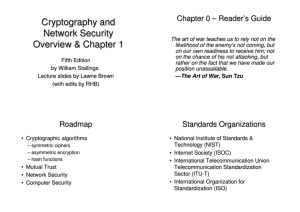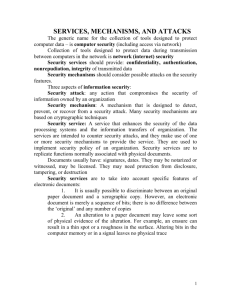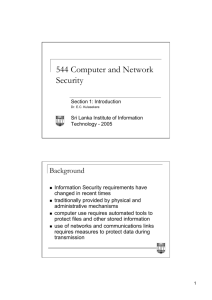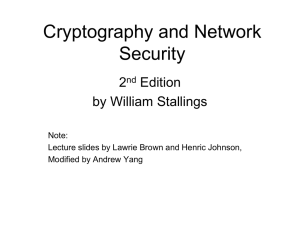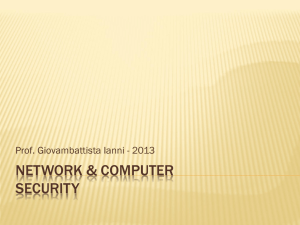1 - SNS Courseware
advertisement
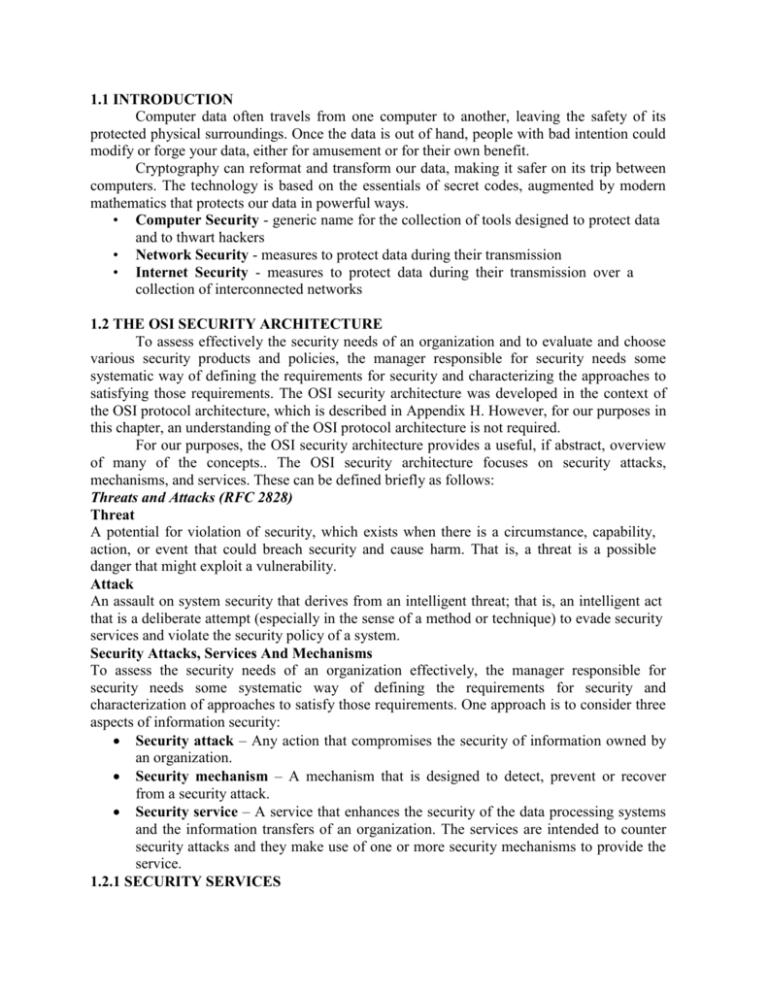
1.1 INTRODUCTION Computer data often travels from one computer to another, leaving the safety of its protected physical surroundings. Once the data is out of hand, people with bad intention could modify or forge your data, either for amusement or for their own benefit. Cryptography can reformat and transform our data, making it safer on its trip between computers. The technology is based on the essentials of secret codes, augmented by modern mathematics that protects our data in powerful ways. • Computer Security - generic name for the collection of tools designed to protect data and to thwart hackers • Network Security - measures to protect data during their transmission • Internet Security - measures to protect data during their transmission over a collection of interconnected networks 1.2 THE OSI SECURITY ARCHITECTURE To assess effectively the security needs of an organization and to evaluate and choose various security products and policies, the manager responsible for security needs some systematic way of defining the requirements for security and characterizing the approaches to satisfying those requirements. The OSI security architecture was developed in the context of the OSI protocol architecture, which is described in Appendix H. However, for our purposes in this chapter, an understanding of the OSI protocol architecture is not required. For our purposes, the OSI security architecture provides a useful, if abstract, overview of many of the concepts.. The OSI security architecture focuses on security attacks, mechanisms, and services. These can be defined briefly as follows: Threats and Attacks (RFC 2828) Threat A potential for violation of security, which exists when there is a circumstance, capability, action, or event that could breach security and cause harm. That is, a threat is a possible danger that might exploit a vulnerability. Attack An assault on system security that derives from an intelligent threat; that is, an intelligent act that is a deliberate attempt (especially in the sense of a method or technique) to evade security services and violate the security policy of a system. Security Attacks, Services And Mechanisms To assess the security needs of an organization effectively, the manager responsible for security needs some systematic way of defining the requirements for security and characterization of approaches to satisfy those requirements. One approach is to consider three aspects of information security: Security attack – Any action that compromises the security of information owned by an organization. Security mechanism – A mechanism that is designed to detect, prevent or recover from a security attack. Security service – A service that enhances the security of the data processing systems and the information transfers of an organization. The services are intended to counter security attacks and they make use of one or more security mechanisms to provide the service. 1.2.1 SECURITY SERVICES The classification of security services are as follows: Confidentiality: Ensures that the information in a computer system and transmitted information are accessible only for reading by authorized parties. Eg., printing, displaying and other forms of disclosure. Authentication: Ensures that the origin of a message or electronic document is correctly identified, with an assurance that the identity is not false. Integrity: Ensures that only authorized parties are able to modify computer system assets and transmitted information. Modification includes writing, changing status, deleting, creating and delaying or replaying of transmitted messages. Non repudiation: Requires that neither the sender nor the receiver of a message be able to deny the transmission. Access control: Requires that access to information resources may be controlled by or the target system. Availability: Requires that computer system assets be available to authorized parties when needed. Security Services (X.800) AUTHENTICATION The assurance that the communicating entity is the one that it claims to be. Peer Entity Authentication Used in association with a logical connection to provide confidence in the identity of the entities connected. Data Origin Authentication In a connectionless transfer, provides assurance that the source of received data is as claimed. ACCESS CONTROL The prevention of unauthorized use of a resource (i.e., this service controls who can have access to a resource, under what conditions access can occur, and what those accessing the resource are allowed to do). DATA CONFIDENTIALITY The protection of data from unauthorized disclosure. Connection Confidentiality The protection of all user data on a connection. Connectionless Confidentiality The protection of all user data in a single data block AUTHENTICATION The confidentiality of selected fields within the user data on a connection or in a single data block. Traffic Flow Confidentiality The protection of the information that might be derived from observation of traffic flows. Connection Integrity with Recovery Provides for the integrity of all user data on a connection and detects any modification, insertion, deletion, or replay of any data within an entire data sequence, with recovery attempted. Connection Integrity without Recovery As above, but provides only detection without recovery. Selective-Field Connection Integrity Provides for the integrity of selected fields within the user data of a data block transferred over a connection and takes the form of determination of whether the selected fields have been modified, inserted, deleted, or replayed. Connectionless Integrity Provides for the integrity of a single connectionless data block and may take the form of detection of data modification. Additionally, a limited form of replay detection may be provided. Selective-Field Connectionless Integrity Provides for the integrity of selected fields within a single connectionless data block; takes the form of determination of whether the selected fields have been modified. NONREPUDIATION Provides protection against denial by one of the entities involved in a communication of having participated in all or part of the communication. Nonrepudiation, Origin Proof that the message was sent by the specified party. Nonrepudiation, Destination 1.2.2 SECURITY MECHANISMS One of the most specific security mechanisms in use is cryptographic techniques. Encryption or encryption-like transformations of information are the most common means of providing security. Some of the mechanisms are: Encipherment Digital Signature Access Control 1.2.3 SECURITY ATTACKS There are four general categories of attack which are listed below. Interruption An asset of the system is destroyed or becomes unavailable or unusable. This is an attack on availability. e.g., destruction of piece of hardware, cutting of a communication line or disabling of file management system. Sender Receive Interception An unauthorized party gains access to an asset. This is an attack on confidentiality. Unauthorized party could be a person, a program or a computer.e.g., wire tapping to capture data in the network, illicit copying of files Sender Receiver Eavesdropper or forger Modification An unauthorized party not only gains access to but tampers with an asset. This is an attack on integrity. e.g., changing values in data file, altering a program, modifying the contents of messages being transmitted in a network. Sender Receiver Eavesdropper or forger Fabrication An unauthorized party inserts counterfeit objects into the system. This is an attack on authenticity.e.g., insertion of spurious message in a network or addition of records to a file. Sender Receiver Eavesdropper or forger A useful categorization of these attacks is in terms of Passive attacks Active attacks Passive attack Passive attacks are in the nature of eavesdropping on, or monitoring of, transmissions. The goal of the opponent is to obtain information that is being transmitted. Passive attacks are of two types: Release of message contents: A telephone conversation, an e-mail message and a transferred file may contain sensitive or confidential information. We would like to prevent the opponent from learning the contents of these transmissions. Traffic analysis: If we had encryption protection in place, an opponent might still be able to observe the pattern of the message. The opponent could determine the location and identity of communication hosts and could observe the frequency and length of messages being exchanged. This information might be useful in guessing the nature of communication that was taking place. Passive attacks are very difficult to detect because they do not involve any alteration of data. However, it is feasible to prevent the success of these attacks. Active attacks These attacks involve some modification of the data stream or the creation of a false stream. These attacks can be classified in to four categories: Masquerade – One entity pretends to be a different entity. Replay – involves passive capture of a data unit and its subsequent transmission to produce an unauthorized effect. Modification of messages – Some portion of message is altered or the messages are delayed or recorded, to produce an unauthorized effect. Denial of service – Prevents or inhibits the normal use or management of communication facilities. Another form of service denial is the disruption of an entire network, either by disabling the network or overloading it with messages so as to degrade performance. It is quite difficult to prevent active attacks absolutely, because to do so would require physical protection of all communication facilities and paths at all times. Instead, the goal is to detect them and to recover from any disruption or delays caused by them. Symmetric and public key algorithms Encryption/Decryption methods fall into two categories. Symmetric key Public key In symmetric key algorithms, the encryption and decryption keys are known both to sender and receiver. The encryption key is shared and the decryption key is easily calculated from it. In many cases, the encryption and decryption keys are the same. In public key cryptography, encryption key is made public, but it is computationally infeasible to find the decryption key without the information known to the receiver.
